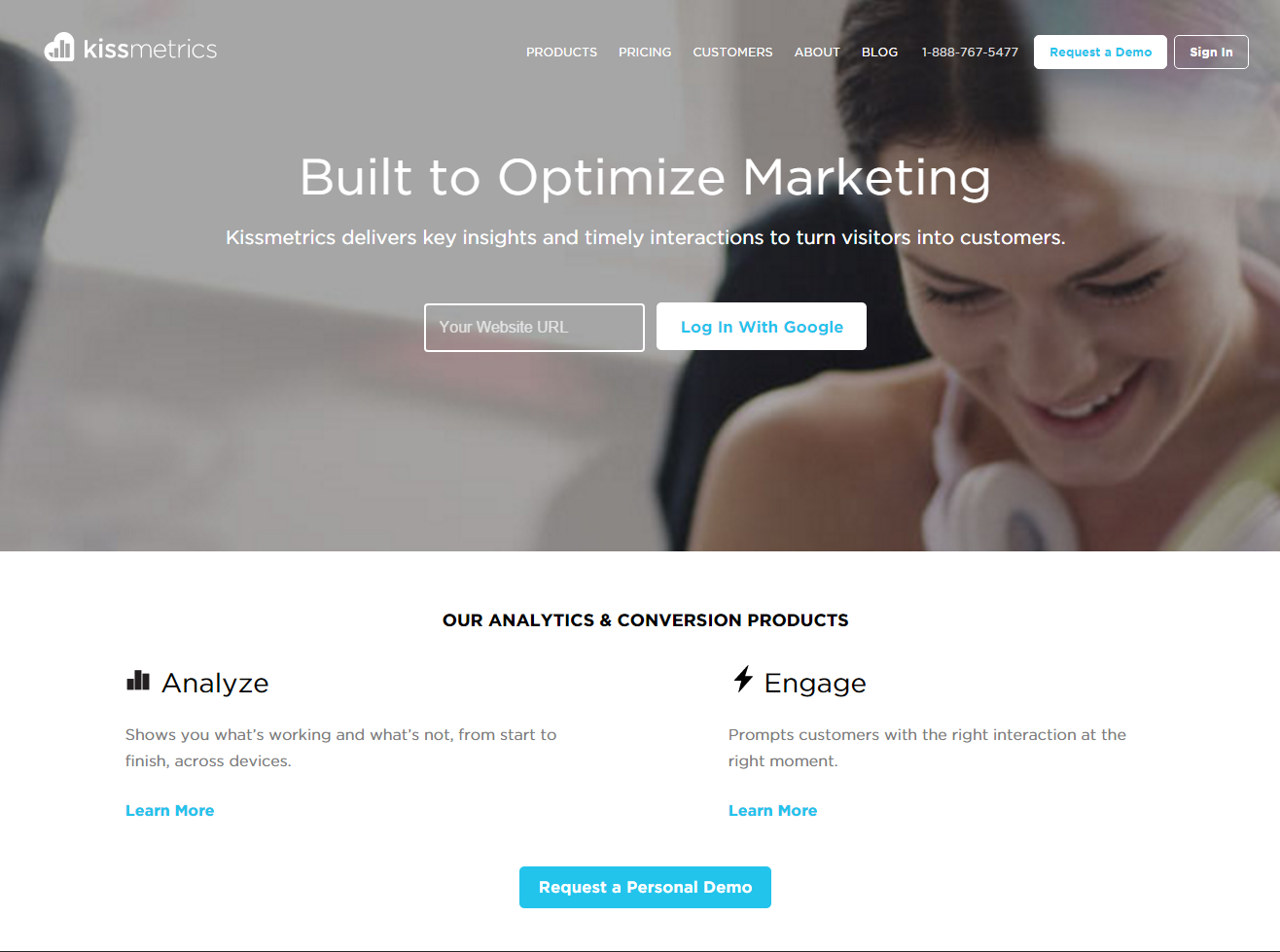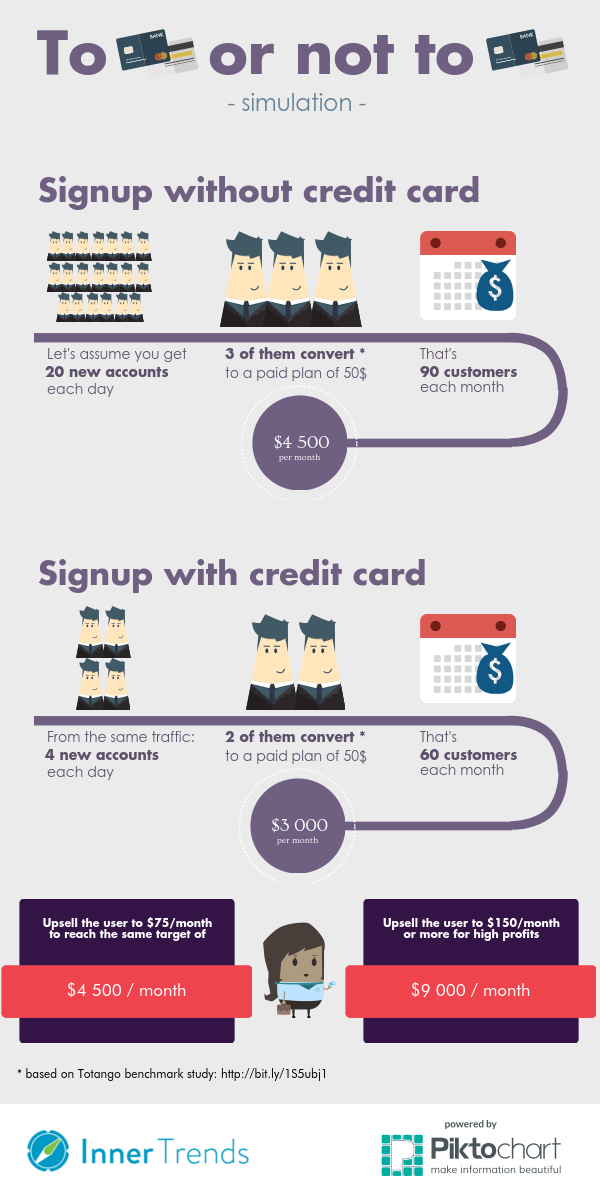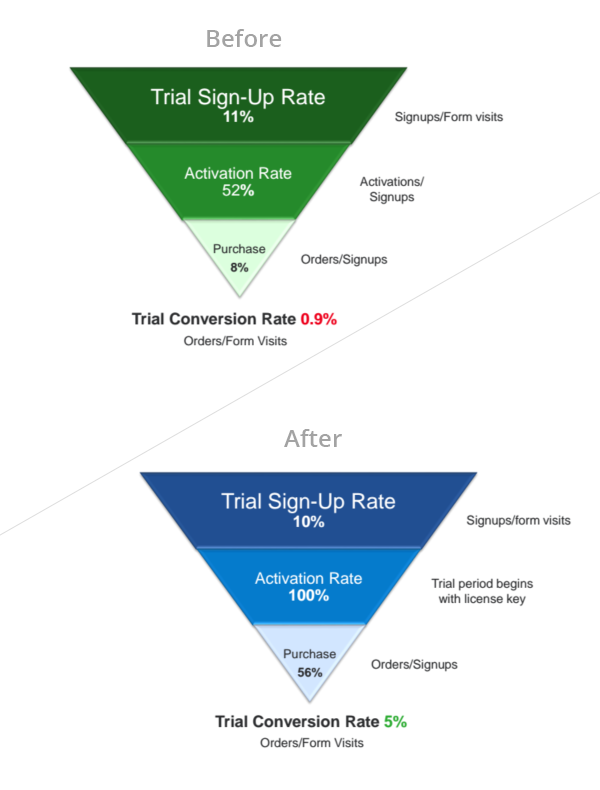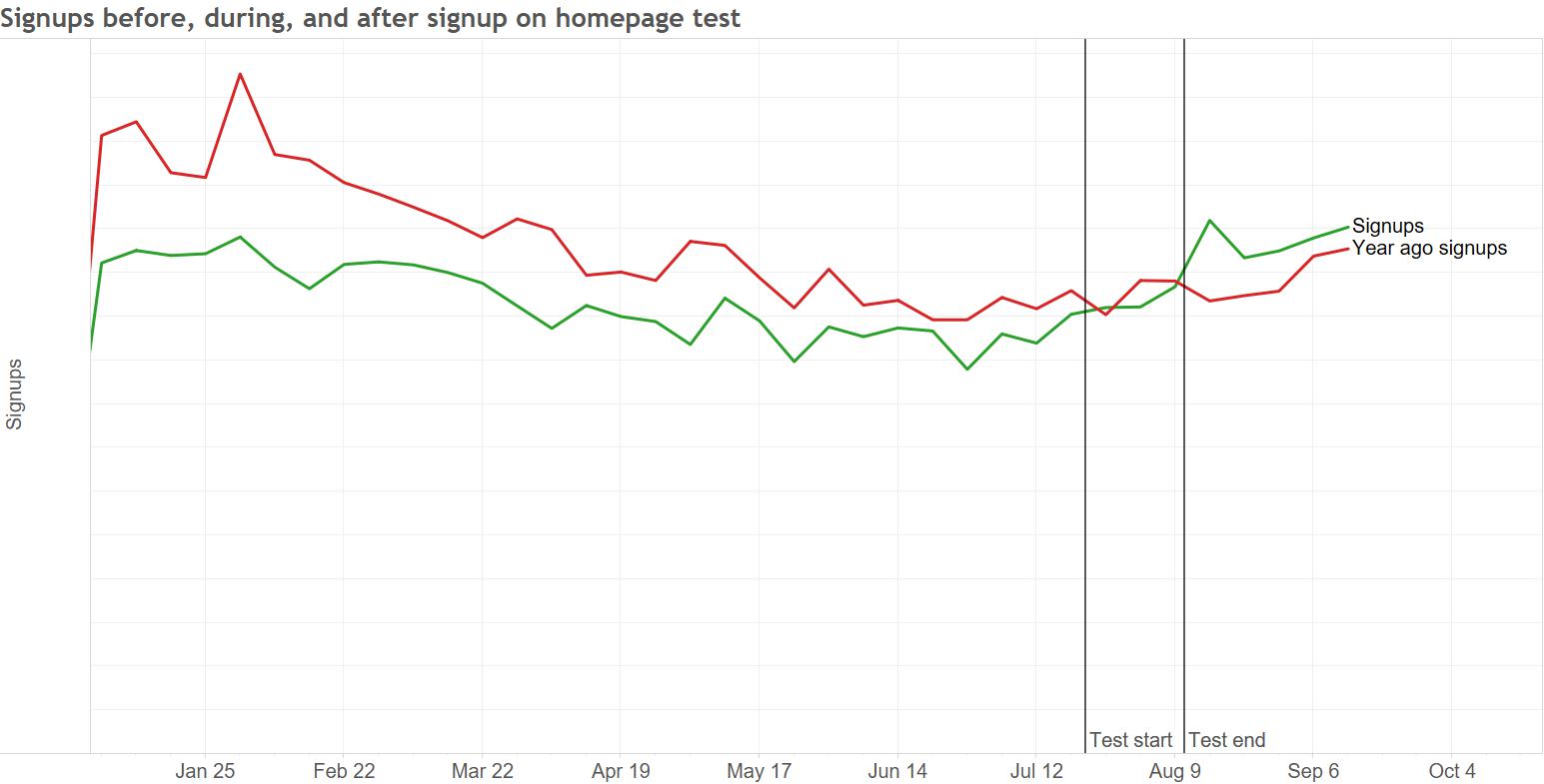Should you encourage people to sign up right away, or is a considered signup better? How do you know which is more suitable for your business?
First though, let’s look at what we mean when we discuss these two methods of bringing new people into your business.
The Fast Signup
The fast signup presents your visitor with the option to sign up for your product or service as soon as they land on your website.
The barrier for signup is kept very low and not too many details are asked for, so even a bit of curiosity will drive a signup. (Be honest, how many times have you been persuaded by the words “No credit card required!” when you were wavering?)
The goal for the fast signup is to bring in as many leads as possible so that there’s a big pool of users to convert into paying customers.
The focus is on quantity rather than quality.
The Considered Signup
The considered signup gives your visitor the opportunity to learn more about your product or service before making a decision to signup.
A considered signup will undoubtedly have fewer initial signups but will retain a lot of committed people who ultimately will become paying customers.
This process takes a bit longer and its focus is on quality rather than quantity.
The fast signup vs. considered signup was argued by Basecamp for years and even experimented on (see the case study at the end of the article).
We asked Noah Lorang from Basecamp what were the most argued points of this debate:
Fast Signup Pro: getting people using the product is the best way to sell it. This removes obstacles to getting people going.
Considered Signup Pro: no point in getting signups from people who aren’t actually interested or for whom the product is a bad fit and getting people to read a little more before they sign up might actually get them to try it more thoroughly/seriously.
So which is better?
There is no ‘one size fits all’ answer to this question. It’s about which method works best for you and your business.
The Impact on Your Business
Jason Lemkin from SaaStr argues for considered signups, or at least a mixed signup strategy.
From Jason’s perspective there is a big difference between the way enterprises sign up (accounting for 85% of revenue) and the way small businesses and regular users sign up (which accounts for the other 15% of revenue).
A small business is interested in getting a free trial or to sign up right away, whereas enterprises have a different approach and are interested in getting a demo of the product.
How many enterprise customers can you close with your small and medium business (SMB) product?
By pushing for the signup right away, not even allowing users to see pricing before signing up, it’s possible that you might alienate enterprise users who just want a demo of your product and to be put in touch with a representative.
Take a look at what Kissmetrics’ homepage used to look like:
 This is the old version of Kissmetrics’ home page. It’s an example of a fast signup: in order to do anything, the user was first required to create an account.
This is the old version of Kissmetrics’ home page. It’s an example of a fast signup: in order to do anything, the user was first required to create an account.This is a scenario typical for companies that focus on the quantity of leads and employ automatic marketing strategies.
However, Kissmetrics seems to have now moved towards a scenario typical for companies interested in the quality of the leads, who employ a sales team to convert them.
 The new version of the home page features a considered signup example. Users are enabled to learn more, request a demo before signing up, or even call for more info.
The new version of the home page features a considered signup example. Users are enabled to learn more, request a demo before signing up, or even call for more info.Let’s Take it a Bit Further
Fast signup is typical for freemium products. Here are a few examples:
- signup for free trial: Basecamp, Crazy Egg, Mention
- signup for free product: Intercom.io
Considered signup is typical for enterprise products, but not limited to them:
- request a demo: ExactTarget, Salesforce
- learn more: Brainient, Wistia, Hootsuite
- credit card first: Moz
Mixed signup strategies are more often used when targeting both small companies and enterprises For example, Dropbox, Hubspot, Avangate, Buffer, Evernote, Trello, Slack
All of the mixed signup strategies started as fast signup only strategies and, over time, added considered signup strategies.
How to Experiment with Fast Signup vs. Considered Signup
Before you Begin
A critical element for any experiment is to set the correct success metric. If you simply ask ‘How many people create an account?’ a fast signup strategy is almost always going to win.
If those newly created accounts become inactive almost right away, your business will not grow, regardless of how many hundreds or thousands of new accounts are created.
Experiment in stages. Choose winners based on immediate results (first order revenue, average order value) while also monitoring the experiment in the longer term via these other metrics.
While it would take at least a full business cycle to declare a winner, it only makes sense to focus on revenue. The question is, which revenue metric?
- First acquisition revenue?
- Lifetime value?
- Average order value or average revenue per customer?
Average revenue per customer, lifetime value or (even better) lifetime value per cost of acquisition would all be relevant metrics to find which signup works best, but it’s going to take a very long time to find your winner.
Establishing Goals
Fast signup will bring you more leads but they may not be quality leads. Automation tools can be used to onboard as many users as possible and convert them into paying customers.
Considered signup will bring you quality leads, but less of them. With less leads to follow up, you have the opportunity to make personal connections with these new users in order to convert them into paying customers.
Based on this information, choose and set appropriate goals. For example:
- I want more leads so I can focus on onboarding and conversion optimization.
- I want enterprise customers to increase average revenue per user.
- I want quality leads so I can build a sales team to convert them.
Let’s play with an example and say I want quality leads so I can build a sales team to convert them.
A typical considered signup strategy for increasing quality leads is to require credit card details when signing up. This causes users to make a considered decision.
Knowing your goal, how do you decide if this strategy is working?

Requesting credit card details during the signup process is a strategy that works for companies like Moz and SEMrush. They have been doing it for years.
It’s important to note that the way you ask for the credit card details in the signup process can have a huge impact on the final results.
According to a case study facilitated by Avangate, Absolute managed an amazing 5x increase of the trial conversion rate. They added a trial sign-up form requiring credit card information in the signup process instead of a simple checkout page with pricing listing at zero dollars. The initial version did not automatically trigger the product activation and auto-billing at the end of the trial period. Users would need to do the activation manually, resulting in trial periods starting late or never starting.
Here is a before and after image for the experiment:

Shannon MacLeod, Sr Director, Conversion Optimization at Avangate ran this experiment and we asked her why she thinks this is the case:
The new trial system improved the user experience and provided clear expectations regarding trial start and end date, product activation and auto-renewal.
The implementation of a true subscription model removed the requirement to activate the software (trial clock starts with completed form), making the user experience frictionless.
Users have the option to turn-off auto billing any time. The end result is that the customer engagement is now focused on education versus “selling”.
The impact of this change was high, as trial conversion rate increased five fold.
Here’s a webinar recorded by Shannon, presenting the case study and the results of the experiment.
In 2012 Totango did a study in which they collected data from 100 online businesses and they analyzed the trial conversion and user retention rates.
The data revealed that free trial signups were more successful when the credit card information was not required.
It’s important to calculate what a considered signup success would look like for you, so be sure to check out this calculator spreadsheet.
Ultimately, the only way to find the best signup process for your business is to test, measure and experiment. What works for one business may not work in exactly the same way for you, but you can not know that without experimenting and testing.
When is a Fast Signup Not Fast Enough
37signals Case Study
Basecamp (formerly 37signals) shared a couple of lessons they learned from their transition. They decided to make their website the home of the company, not just the home of the product. Major changes were made to the brand, products and design during this process.
One of the most significant changes was the removal of the signup form from the homepage. This can’t be described as a considered decision. They didn’t do any extensive research or testing on the signup process.
Neither was the decision made based on data. They didn’t have a measured way to see how this change would impact the signups and they didn’t explicitly decide to go for a considered signup system.
Instead, they simply wanted to keep a consistent image during a time of transition. No one paid attention to what this change might mean.
However, after implementing the changes in February 2014, they did notice a fall in their conversion rate. The number of people who were signing up to the new Basecamp website decreased despite press coverage and more traffic.

Source: Signal v. Noise blog
Without planning on doing so, they had accidentally implemented a considered signup system.
In the fall of 2014, when signups didn’t start picking up, they started asking questions.
Things didn’t improve during the first half of 2015 either and, even though the topic was discussed regularly within the company, no major changes were made.
Finally, in July 2015, Basecamp launched an A/B test with the old signup form back on the homepage. The signups immediately increased by 16%. It quickly became apparent that they had lost millions of dollars by delaying the split test for so long.

Source: Signal v. Noise blog
What we learned from this experience:
- Running an A/B test can help you catch the leaks and draw a direct connection between the changes you’re making and the signup rates. It can become really easy to just ignore or delay testing the changes being implemented.
- Be sure to share your ideas with the team. Discussing the change with them might bring up the risks involved. In this particular scenario, it took six months for the problem to be identified due to a lack of communication.
To Sum it All Up
There’s no one size fits all. You have to decide which type of signup is best for your business.
Always test. Absolute adjusted their credit card requirements and managed a 5x increase in sales because of it.
Simulating different signup strategies for your SaaS can reveal the easiest path to more profit.

